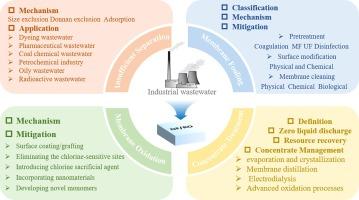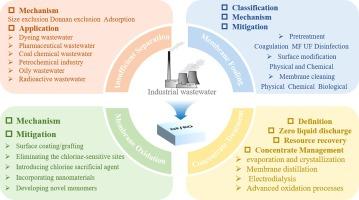Reverse osmosis and nanofiltration processes in industrial wastewater treatment: The recent progress, challenge, and future opportunity
IF 9
1区 工程技术
Q1 ENGINEERING, CHEMICAL
引用次数: 0
Abstract
The expansion of industrial activities has generated a substantial amount of wastewater containing high concentrations of hazardous substances, presenting considerable environmental and health hazards. Membrane technologies, including nanofiltration (NF) and reverse osmosis (RO), have become integral to the treatment and reuse of industrial wastewater, offering high separation efficiency, low energy consumption, and environmental sustainability. This paper provides a comprehensive review of the current state, challenges, and potential solutions associated with NF/RO treatment in industrial wastewater management. It offers an overview of the characteristics of various industrial wastewaters and relevant treatment advancements. This paper proposes the challenges and corresponding solutions in treating industrial wastewater, specifically focusing on strategies for mitigating membrane fouling through pretreatment, membrane modification, and effective cleaning techniques. Additionally, this study provides approaches to minimize membrane oxidation and manage NF/RO concentrates, while considering prospects such as zero liquid discharge (ZLD) and resource recovery from concentrates. This work suggests future research directions and offers theoretical perspectives for advancing NF and RO processes in industrial wastewater treatment.


工业废水处理中的反渗透和纳滤工艺:最新进展、挑战和未来机遇
工业活动的扩大产生了大量含有高浓度有害物质的废水,对环境和健康造成了相当大的危害。包括纳滤(NF)和反渗透(RO)在内的膜技术具有分离效率高、能耗低和环境可持续发展等优点,已成为工业废水处理和再利用不可或缺的技术。本文全面回顾了工业废水管理中与纳滤/反渗透处理相关的现状、挑战和潜在解决方案。本文概述了各种工业废水的特点以及相关的处理进展。本文提出了处理工业废水所面临的挑战和相应的解决方案,特别侧重于通过预处理、膜改性和有效清洁技术来减轻膜污垢的策略。此外,本研究还提供了尽量减少膜氧化和管理 NF/RO 浓缩物的方法,同时考虑了零液体排放(ZLD)和从浓缩物中回收资源等前景。这项工作提出了未来的研究方向,并为在工业废水处理中推进纳滤和反渗透工艺提供了理论视角。
本文章由计算机程序翻译,如有差异,请以英文原文为准。
求助全文
约1分钟内获得全文
求助全文
来源期刊

Separation and Purification Technology
工程技术-工程:化工
CiteScore
14.00
自引率
12.80%
发文量
2347
审稿时长
43 days
期刊介绍:
Separation and Purification Technology is a premier journal committed to sharing innovative methods for separation and purification in chemical and environmental engineering, encompassing both homogeneous solutions and heterogeneous mixtures. Our scope includes the separation and/or purification of liquids, vapors, and gases, as well as carbon capture and separation techniques. However, it's important to note that methods solely intended for analytical purposes are not within the scope of the journal. Additionally, disciplines such as soil science, polymer science, and metallurgy fall outside the purview of Separation and Purification Technology. Join us in advancing the field of separation and purification methods for sustainable solutions in chemical and environmental engineering.
 求助内容:
求助内容: 应助结果提醒方式:
应助结果提醒方式:


